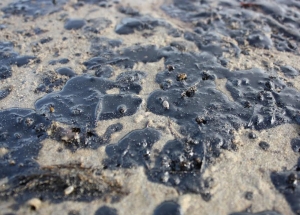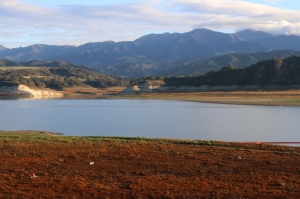
Oiled sand on Rufugio Beach trapping sand crabs below. Photo taken by Nick Schooler on May 19, 2015.
On May 19, 2015, an estimated 21,000 gallons of oil spilled into the Pacific Ocean when a faulty pipeline burst on the Gaviota Coast. Migrating mom and calf gray whales hug this stretch of barely developed coastline each year from January through May, and it’s always home to dolphins, pelicans, shore birds, sea lions, fish, lobster, and dozens of invertebrates. This disaster is harming wildlife, and enraging citizens across the state and beyond.

On Jan. 28, 1969, a blowout on a Unocal rig six miles off the coast of California spilled 3 million gallons of oil into the waters off Santa Barbara. The blackened beaches and oil-soaked birds and seals became icons for the environmental movement. Photo and caption by Bob Duncan via Creative Commons, all rights reserved.
And it should. In 1969, 3 million gallons of oil spilled into the Pacific not far from the current heartbreak in Santa Barbara, California. The silver lining was that the tragedy spawned many great things: the Marine Science Institute at the University of California, Santa Barbara; Earth Day; and a strong environmental movement the swept the nation eventually resulting in the birth of the U.S. Environmental Protection Agency, the National Marine Sanctuary system, and several environmental laws. Oil spills kill animals, degrade habitats, and provoke humans to make necessary positive changes. In other words, they piss people off.
I am pissed off.
But I am also miffed by the conscience and compassionate Californians who are chomping at the bit to assist oil spill efforts in any way possible, but are seemingly unmotivated to make similar types of sacrifices to address our water problem. Californians: I understand why you are passionate over oil and I share your feelings of horror, urgency, and helplessness, but I can’t wrap my head around why you are not just as passionate about water.
What about water?
What if on May 19, 2015 there had been no oil spill, but instead you had turned on your faucet and no water came out. Or you had gone to the grocery store to buy guacamole ingredients and the mountain of avocados were replaced with a sign that said, “No avocados for the foreseeable future. No water.” I bet you’d be pissed off. And you should be.
I am pissed off.

Cachuma Lake in January of 2015, photo by Santa Barbara County via Creative Commons, all rights reserved.
In California, we are experiencing the worst drought ever, not the worst oil spill in five decades. Experts predict that as early as October, there will be no usable water in Cachuma Lake—Santa Barbara’s primary water source. Currently, Santa Barbara is unsure where its water will come from in 2017. But because the problem isn’t washing up on our beloved beaches, it’s easy to overlook.
Ok, I’m being harsh. I know people are not blind to the drought. It’s all over the news, and lots of people are taking action (see: “Droughtshaming”). But unfortunately, not enough people (and this should more accurately read: institutions—agriculture is the biggest water user in the state; fuel production is also extremely water-intensive) are making collective positive changes yet to make a dent in the problem.
In Santa Barbara, there is an out pour of time and energy dedicated to the Refugio Oil Spill. Understatedly, it is an unfortunate event that will again shape history, and our community’s response to it is both impressive and inspirational. Just as it was in 1969. But truth be told, if I had a magic wand I would redirect at least some of the public’s current vitality to water conservation.

Trained oil spill responders literally combing Coal Oil Point Reserve to clean spilled oil. Coal Oil Point Reserve at UC Santa Barbara is protected nesting habitat for Western Snowy Plovers. Photo taken on May 26, 2015 by Callie Bowdish, all rights reserved.
Regarding the spill, there is a clear (ir)responsible party with oil on their hands: Plains All American. Even if it takes years of litigation, they** will pay for the cleanup and hopefully the prevention of future spills, and then some. Teams of ~1,000 highly trained oil spill responders have been working diligently since the burst pipe was discovered. They have already collected over 100,000 gallons of oily water (10-30% oil mixed with seawater) from around the spill. Local wildlife rescue organizations and public volunteers are assisting, as well. Many hands and hearts are needed to stop the bleeding, and fortunately that’s exactly what we’ve got in Santa Barbara. It will likely take many months to nurse our precious coastline and its animals back to health. I am confident this event will be another spark igniting the next wave of real progress towards sustainable energy solutions.
…Who is the clear party responsible for our drought? Better yet, who is accountable for helping to minimize the negative consequences of our drought? Who has to pay?

A farmer wipes his eyes after driving through dry fields in near the town of Huron in California’s San Joaquin Valley. Photo by Scott Anger via Creative Commons, all rights reserved.
You, and me. Californians. That’s who. The same people agonizing over the Refugio Oil Spill. The same people making direct and indirect, consistent water withdrawals from a negative balance every day. We demand products that are insanely water intensive at low prices every day. It’s no secret; California’s water budget is in the red.
Californians: I am not suggesting we curb our passion for healthy coasts and sustainable energy solutions. I am challenging us all to dedicate passion, energy, and time to doing our part to abate our ongoing horrendous and catastrophic drought. We’ve shown that we have what it takes to be the catalyst for unprecedented positive environmental change. With that in mind, here are some things that we can do to be an active part of the water scarcity solution:
Large Impacts at the State Level:
-
Be willing to pay a higher price for water. Funds may go towards infrastructure upgrades and developing new water sources like desalination and reclamation.
- Be open to supporting other out-of-the-box institutional solutions, like reorganizing California’s water rights; and governments paying farmers to use water-conserving equipment and to reduce production. To really get a handle on water issues we need to make substantial changes to the way we produce and consume our food. Our choices over what we eat and how it ends up on our plates (think energy…) is really important. And yes, this may mean your guacamole ingredients become seasonal and/or more expensive. We will be just fine eating seasonal-appropriate foods, I promise. Jobs as we know them may not be OK. This is a tough problem to solve and it may mean job losses and/or alternatives in California. Read more here and here.
Smaller Impacts at Home:
-

An Alameda, CA home landscaped with low water use succulents that are easy to maintain. Photo and abbreviated caption by Feix Landscape Design via Creative Commons.
Convert your lawn to a native or another semiarid-tolerate landscape. Check out a free California-friendly landscape class. And in locations like Santa Barbara there are rebate programs that provide a financial incentive to make these water-savvy adaptations.
- Replace your old appliances with Energy Star and/or WaterSense appliances. Did you know that toilets are often the main source of indoor water use? On average, toilets account for 30% of residential water consumption. You may be eligible for a rebate if you install a high-efficiency toilet.
**This is misleading. The reality is much more complicated than this. “They,” as in Plains All American, likely will not be footing the bill directly. Their insurance company, and often with larger spills the US government, and last but not least you and me pay at the pump for cleanups. (And you would be shocked to learn the number of U.S. spills each year—it’s hundreds.) Read about the Oil Pollution Act of 1990, which was passed in response to the Exxon Valdez oil spill and in effect added much complexity to the mind-bogglingly lucrative oil industry, and the Oil Spill Liability Trust Fund for details. The oil industry is a disgusting one, and how cleanups work is just one reason why.


